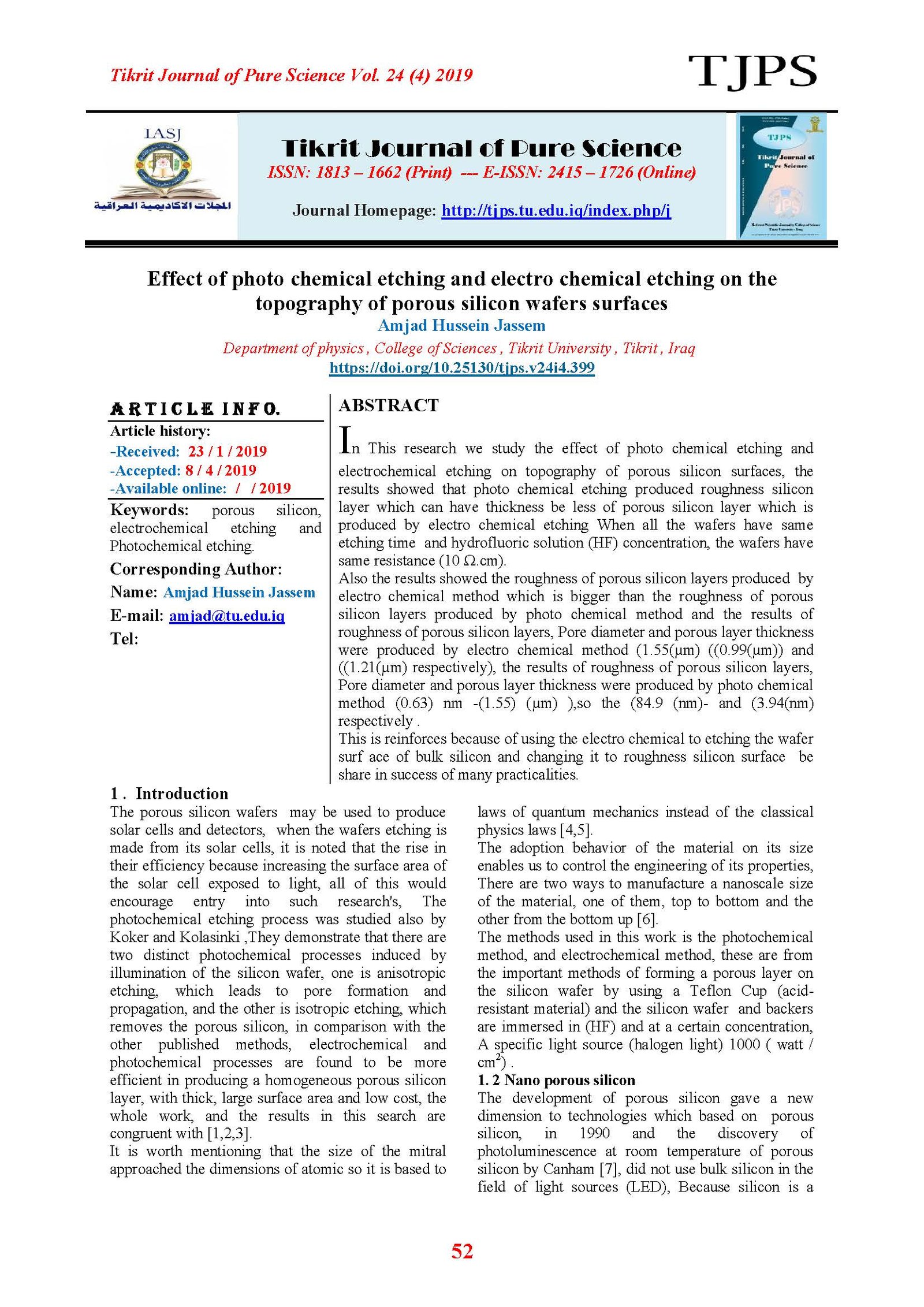Effect of photo chemical etching and electro chemical etching on the topography of porous silicon wafers surfaces
Main Article Content
Abstract
In This research we study the effect of photo chemical etching and electrochemical etching on topography of porous silicon surfaces, the results showed that photo chemical etching produced roughness silicon layer which can have thickness be less of porous silicon layer which is produced by electro chemical etching When all the wafers have same etching time and hydrofluoric solution (HF) concentration, the wafers have same resistance (10 Ω.cm).
Also the results showed the roughness of porous silicon layers produced by electro chemical method which is bigger than the roughness of porous silicon layers produced by photo chemical method and the results of roughness of porous silicon layers, Pore diameter and porous layer thickness were produced by electro chemical method (1.55(µm) ((0.99(µm)) and ((1.21(µm) respectively), the results of roughness of porous silicon layers, Pore diameter and porous layer thickness were produced by photo chemical method 0.63)) nm -1.55)) (µm) ),so the (84.9 (nm)- and (3.94(nm) respectively .
This is reinforces because of using the electro chemical to etching the wafer surf ace of bulk silicon and changing it to roughness silicon surface be share in success of many practicalities.
Article Details

This work is licensed under a Creative Commons Attribution 4.0 International License.
Tikrit Journal of Pure Science is licensed under the Creative Commons Attribution 4.0 International License, which allows users to copy, create extracts, abstracts, and new works from the article, alter and revise the article, and make commercial use of the article (including reuse and/or resale of the article by commercial entities), provided the user gives appropriate credit (with a link to the formal publication through the relevant DOI), provides a link to the license, indicates if changes were made, and the licensor is not represented as endorsing the use made of the work. The authors hold the copyright for their published work on the Tikrit J. Pure Sci. website, while Tikrit J. Pure Sci. is responsible for appreciate citation of their work, which is released under CC-BY-4.0, enabling the unrestricted use, distribution, and reproduction of an article in any medium, provided that the original work is properly cited.
References
[1] Ahmad, Y.Kh. (2018). preparing the porous silicon wafers by using sun energy. M.Sc. Tikrit University, Tikrit, Iraq.
[2] Alaa, Y. A. (2011). Synthesis and Study of the Characteristics of a CdS Cytoskeletal Reagent in Thermal Chemical Spraying Method. M. Sc. Tikrit University, Iraq.
[3] Hassin, A.k.(1999). Study effect NcLl: TAC Pulse laser on electrical properties of (K3)super conductions of high Temperichers. M.Sc. Tikrit University, Iraq.
[4] Mohammad, S.A. (2007). Introduction to Nanotechnology. Ph.D. collage of Science - Physics Department And Astronomy - King Saud University.
[5] Mark, R. (2002(. Nanotechnology Gentle Introduction. Ph.D. Brown University, USA.
[ 6 ] Axel, Z. (2004). Technological analysis, Future technologies division. Germany's Journal of Physics 7(2) : 43-52 .
[7]Canham, L. (1990(. properties of porous silicon. Chines Journal of Physics. 57(2): 18-2.
[8] Gullis, A. (1991(. Quantum well, wires and dots. Materials science and Engineering Journal, 65(4): 150-152.
[ 9 ] Mukarram, A. (2007). Production of Porous Silicon Studying Its Electrical Properties. M.Sc. Department of Laser and Optoelectronic Engineering, University of Technology, Iraq.
[ 10 ] Alicia, I.(2003(. Light emitting devices based on silicon nanostructures. M.Sc. University of Edgily, Georgia.
[ 11 ] Alwan, M. (2005(. Electrical properties of porous silicon prepared by photo chemical etching. Ph.D. University of Bagdad, Iraq.
